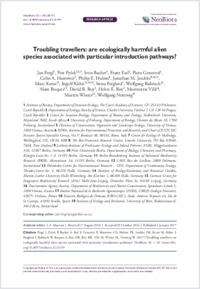Troubling travellers: are ecologically harmful alien species associated with particular introduction pathways?
- Pergl, Jan Institute of Botany, Department of Invasion Ecology, The Czech Academy of Sciences, CZ-252 43 Průhonice, Czech Republic
- Pyšek, Petr Institute of Botany, Department of Invasion Ecology, The Czech Academy of Sciences, CZ-252 43 Průhonice, Czech Republic - Department of Ecology, Faculty of Science, Charles University, Prague, Czech Republic - Centre for Invasion Biology, Department of Botany and Zoology, Stellenbosch University, South Africa
- Bacher, Sven University of Fribourg, Department of Biology, Switzerland
- Essl, Franz Division of Conservation, Vegetation and Landscape Ecology, University of Vienna, Austria
- Genovesi, Piero ISPRA, Institute for Environmental Protection and Research, and Chair of IUCN SSC Invasive Species Specialist Group, Rome, Italy
- Harrower, Colin A. Centre for Ecology & Hydrology, Wallingford, UK
- Hulme, Philip E. The Bio-Protection Research Centre, Lincoln University, New Zealand
- Jeschke, Jonathan M. Leibniz-Institute of Freshwater Ecology and Inland Fisheries (IGB), Müggelseedamm Berlin, Germany - Freie Universität Berlin, Department of Biology, Chemistry and Pharmacy, Berlin, Germany - Berlin-Brandenburg Institute of Advanced Biodiversity Research (BBIB), Berlin, Germany
- Kenis, Marc CABI, Rue des Grillons, Delémont, Switzerland
- Kühn, Ingolf Helmholtz Centre for Environmental Research – UFZ, Department of Community Ecology, Halle, Germany - Institute of Biology/Geobotany and Botanical Garden, Martin-Luther-University Halle-Wittenberg, Germany - German Centre for Integrative Biodiversity Research (iDiv) Halle-Jena-Leipzig, Leipzig, Germany
- Perglová, Irena Institute of Botany, Department of Invasion Ecology, The Czech Academy of Sciences, CZ-252 43 Průhonice, Czech Republic
- Rabitsch, Wolfgang Environment Agency Austria, Department of Biodiversity and Nature Conservation, Vienna, Austria
- Roques, Alain Institut National de la Recherche Agronomique (INRA), UR633 Zoologie Forestière, Orléans, France
- Roy, David B. Centre for Ecology & Hydrology, Wallingford, UK
- Roy, Helen E. Centre for Ecology & Hydrology, Wallingford, UK
- Vilà, Montserrat Estación Biológica de Doñana (EBD-CSIC), Avda. Américo Vespucio s/n, Isla de la Cartuja, Sevilla, Spain
- Winter, Marten German Centre for Integrative Biodiversity Research (iDiv) Halle-Jena-Leipzig, Leipzig, Germany
- Nentwig, Wolfgang Institute of Ecology and Evolution, University of Bern, Switzerland
-
04.01.2017
Published in:
- NeoBiota. - 2017, vol. 32, p. 1–20
English
Prioritization of introduction pathways is seen as an important component of the management of biological invasions. We address whether established alien plants, mammals, freshwater fish and terrestrial invertebrates with known ecological impacts are associated with particular introduction pathways (release, escape, contaminant, stowaway, corridor and unaided). We used the information from the European alien species database DAISIE (www.europe-aliens.org) supplemented by the EASIN catalogue (European Alien Species Information Network), and expert knowledge.Plants introduced by the pathways release, corridor and unaided were disproportionately more likely to have ecological impacts than those introduced as contaminants. In contrast, impacts were not associated with particular introduction pathways for invertebrates, mammals or fish. Thus, while for plants management strategies should be targeted towards the appropriate pathways, for animals, management should focus on reducing the total number of taxa introduced, targeting those pathways responsible for high numbers of introductions. However, regardless of taxonomic group, having multiple introduction pathways increases the likelihood of the species having an ecological impact. This may simply reflect that species introduced by multiple pathways have high propagule pressure and so have a high probability of establishment. Clearly, patterns of invasion are determined by many interacting factors and management strategies should reflect this complexity.
- Faculty
- Faculté des sciences et de médecine
- Department
- Département de Biologie
- Language
-
- English
- Classification
- Ecology and biodeversity
- License
-
License undefined
- Identifiers
-
- RERO DOC 279048
- DOI 10.3897/neobiota.32.10199
- Persistent URL
- https://folia.unifr.ch/unifr/documents/305202
Statistics
Document views: 187
File downloads:
- pdf: 169
